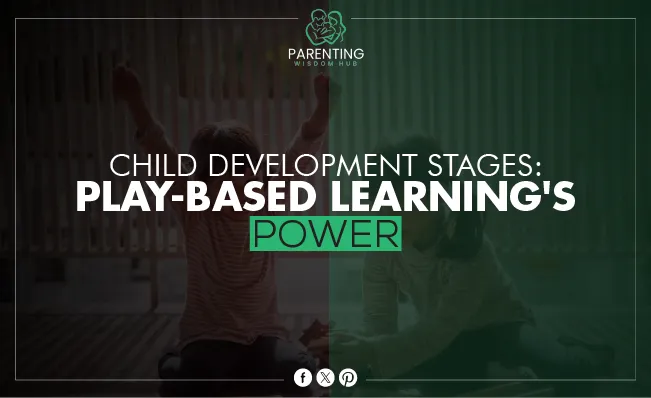Introduction
Play-based preschool education is extremely important. Teaching kids these abilities helps them have fun with friends, explore, find things, negotiate, go to new places, and make sense of things. It helps youngsters develop mentally, socially, emotionally, and physically while gratifying their inherent curiosity. This paper discusses the child development stages through how play-based learning can help preschoolers thrive and prepare for school.
Find out more about formative years.
The Role of Play in Cognitive Development
Play contributes to the advancement of cognitive development through various mechanisms:
Problem-Solving Skills:
Preschoolers develop problem-solving skills by engaging in experiential learning and resolving diverse challenges.
Creativity Enhancement:
Frequently, imaginative scenarios are incorporated into play-based learning, which can stimulate creative thought.
Language Development:
Interaction facilitates language development by exposing children to new vocabulary and enhancing their comprehension of sentence structure.
Concentration:
Children’s attention spans can be extended through play-based activities, especially when the children find the activities pleasurable.
Mathematical thinking:
Shape recognition, counting, and pattern recognition games can cultivate fundamental mathematical potential concepts in young children.
Promoting Social Skills Through Play
Emotional Intelligence:
Children encounter and acquire the ability to regulate various emotions through play. This may enhance their capacity for emotional intelligence.
Collaboration:
Children are encouraged to cooperate, share, and work as a team through frequent peer interaction during play.
Communication:
Children develop verbal and nonverbal communication abilities by exploring ideas, emotions, and thoughts during play.
Respect for Others:
Engaging in play activities with peers from various backgrounds enables children to gain insights into the unique qualities and characteristics of others, thereby promoting the development of mutual respect and understanding.
Conflict Resolution:
Opportunities to develop conflict resolution skills, including compromise, negotiation, and problem-solving, are presented by playground disputes.
Impact of Play on Emotional Well-being
Development of Resilience:
Frequently, play-based activities entail obstacles and difficulties. Children’s emotional health is promoted by developing resilience and perseverance from overcoming these obstacles.
Stress Relief:
Engaging in play naturally functions as a tension reliever for children. It allows individuals to discharge accumulated energy and emotions, reducing tension and fostering feelings of joy.
Self-Esteem and Confidence:
Children’s accomplishment of objectives or victory in a game enhances their self-confidence and esteem. Positive emotions make a substantial contribution to one’s emotional well-being.
Coping Skills:
Play can simulate a wide range of scenarios, including failure and loss. By navigating these circumstances, children gain the ability to cultivate coping mechanisms that empower them to confront actual setbacks or disappointments.
Emotional Expression:
The play allows children to articulate their emotions in a secure and encouraging setting. Engaging in this form of emotional expression has the potential to promote emotional well-being.
Play-based Learning vs Traditional Learning Methods
Learning Pace:
The curriculum and instructor frequently determine the tempo of conventional learning. In contrast, play-based learning cultivates an individualized learning environment by permitting children to progress at their learning rate.
Engagement:
Although conventional approaches may occasionally result in dormant learning, play-based learning promotes active engagement and enhances the enjoyment of the learning process.
Learning Through Doing:
Frequently, conventional learning is predicated on theory. On the other hand, play-based learning enables youngsters to “learn by doing,” which can improve knowledge retention and comprehension.
Innovation and Creativity:
In contrast to conventional learning approaches that frequently prioritize memorization, play-based learning cultivates ingenuity and advancement. It inspires children to generate novel concepts and engage in unconventional thinking.
Holistic Development:
Although academic skills are frequently the focal point of traditional approaches, play-based learning promotes the comprehensive development of children. In addition to cognitive development, it fosters physical, emotional, and social growth.
Motivation:
Enhancing the learning experience through play can cultivate intrinsic motivation among children. This opposes conventional approaches, which frequently depend on extrinsic incentives or penalties to stimulate learning.
Practical Tips for Incorporating Play-based Learning
Strategies for Parents
Create a Play-friendly Environment:
Parents can foster an environment conducive to play at home by providing stimulation. This may include various outdoor and interior areas with craft materials, toys, and objects stimulating curiosity and investigation.
Incorporate Learning into Play:
Parents can integrate educational components into play in a seamless manner. Storybooks can be used to promote language abilities, while puzzles and games can be utilized to teach problem-solving.
Play Together:
Engaging in play activities alongside children fosters a stronger parent-child relationship. It allows parents to discreetly influence the child’s development, promote teamwork, and serve as role models in social conduct.
Techniques for Educators
Create a Balanced Curriculum:
Educators can develop a balanced curriculum through the integration of academics and recreation. This strategy can increase children’s participation and enthusiasm by making learning more enjoyable and interesting.
Use Play as a Teaching Tool:
Instructors may employ play as a productive pedagogical instrument. For example, role-playing can be an instructional method in social studies or science, whereas engaging in block play can foster mathematical reasoning.
Facilitate Rather Than Direct:
Play-based learning transforms the educator’s function from a director to a facilitator. Educators can oversee, direct, and encourage pupils while they engage in play, interceding only when it is essential to facilitate learning without interfering with the play experience.
It is vital to strike a balance between structured and unstructured play. While permitting children autonomy in their exploration and learning process, providing guidance and scaffolding is essential when needed.
Case Studies and Examples
Case Study: Forest Kindergarten in Germany
Forest kindergartens are common in Germany. Children spend much of the day exploring nature. Nature-based activities include identifying plants and animals, weather trends, and trail navigation. This teaching method encourages curiosity, self-confidence, and respect for nature. Research shows that forest kindergartens help kids develop advanced motor abilities, resilient physical health, and exceptional problem-solving and social skills.
Example: Montessori Education
Dr. Maria Montessori’s child-centered method is based on scientific observations of infants and adults. It creates an environment where kids can work organically. We encourage children’s inherent passion for learning with spontaneous, engaging activities with a qualified adult. They develop social skills, emotional maturity, physical coordination, and cognitive readiness. The holistic curriculum, delivered by a certified instructor, offers kids time to enjoy studying, build self-esteem, and gain learning experiences.
These examples demonstrate how play-based learning can promote child development in schools. Immersing children in surroundings that foster curiosity, creativity, and exploration can create lifelong learners.
Conclusion
In conclusion, play-based learning uses children’s innate curiosity and creativity to foster cognitive, emotional, social, and physical development. Play-based learning works, whether in a German woodland kindergarten or Montessori. Using such inventive ways, we move beyond rote memorization and build a learning environment that fosters lifelong learners with resilience, stress-coping mechanisms, and a love of learning. As parents and educators, we must provide abundant opportunities for children to play, explore, and learn in a supportive and exciting setting.
Frequently Asked Questions (FAQs)
Q1. What is play-based learning?
Play-based learning teaches kids concepts and skills through games and activities. It assumes children learn best when they are actively involved.
Q2. How does play-based learning differ from traditional learning methods?
Play-based learning promotes experiential learning, while traditional techniques emphasize rote memory. Play lets kids learn at their speed and develop a love of learning.
Q3. How can parents incorporate play-based learning at home?
Parents can establish a play-friendly environment at home by combining learning into play and playing with their kids. This enhances parent-child bonds, learning, and social behavior modeling.
Q4. How do educators facilitate play-based learning?
Educational directors can become facilitators, balance academics with play, and use play as a teaching technique. They assist youngsters in their play to boost learning without taking over.
Q5. Can you provide some examples of play-based learning?
The German Forest Kindergarten spends most of its day outdoors exploring nature, and the Montessori approach fosters spontaneous, purposeful activities under adult supervision.


